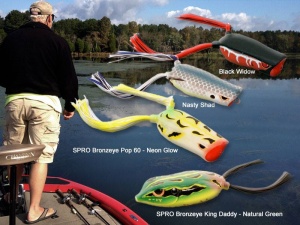 The SPRO frog only tournament is rapidly approaching and Oct. 10 2015 looks to be a special day; if the early frog bite is any indication, get ready! It’s been several years since the frog bite in August was good but this year seems to be the best of them in quite a while. The keys to the early frog bite seem to be finding some typical locations throughout the lake.
The SPRO frog only tournament is rapidly approaching and Oct. 10 2015 looks to be a special day; if the early frog bite is any indication, get ready! It’s been several years since the frog bite in August was good but this year seems to be the best of them in quite a while. The keys to the early frog bite seem to be finding some typical locations throughout the lake.
Choosing the correct grass mats is always important; but you can eliminate unproductive water with just a little thought and some basic visual keys can get you to the best waters. I like to first of all look for the current and see how it relates to the grass mats around the river ledges or the mats on the back side. When you see the current moving water around a bend in the grass you probably have a honey hole. Drop offs especially the ones that relate to the bank and the grass that pushes out from the grass and ends at a steep drop in water depth; the quick drop gives the bass a safe haven if they feel threatened.
Anglers should always use one of their sixth senses, hearing to examine mats of grass. The sound of crackling or popping around a mat indicates the presence of bluegill feeding on bugs on top of the water. This indicates that the bass are under the mats as they will follow the bluegill and feed on them and create activity in the grass. As we all know ditches, creek beds, roadbeds all become high ways for bass to feed, couple these traditional highways with some obvious current, some popping bluegill and proximity to some depth and you have the ideal frog spot.
One thing I always tell my clients is to look for ickiest, dirtiest, nastiest grass mat you can find; as the slim on top covers the grass from getting sunlight causing the grass down under the slim to rot creating a void for the bass to sit in and feed. Open spaces, blow holes, boat paths or man-made paths all create angles for bass to feed around and will be productive grass areas.
To Fish With Captain Mike Gerry on Lake Guntersville visit: fishlakeguntersvilleguideservice.com